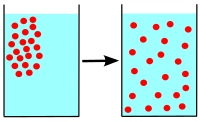
Photo from wikipedia
The purpose of this study was to develop an analytical expression for a fractional motion (FM) diffusion model to characterize diffusion‐induced signal attenuation in a twice‐refocused spin‐echo (TRSE) sequence that… Click to show full abstract
The purpose of this study was to develop an analytical expression for a fractional motion (FM) diffusion model to characterize diffusion‐induced signal attenuation in a twice‐refocused spin‐echo (TRSE) sequence that is resilient to eddy currents, and to demonstrate its applicability to human brain imaging in vivo. Based on the FM theory, which provides a unified statistical description for Langevin motions, the diffusion‐weighted (DW) MR signal was measured with a TRSE sequence that balances the concomitant gradients. The analytical expression was fitted to a set of DW images acquired with 14 b‐values (0–4000 s/mm2) from a total of 10 healthy human subjects at 3 T, yielding three FM parameter maps based on anomalous diffusion coefficient Dφ, ψ, diffusion increment variance φ, and diffusion correlation ψ, respectively. These parameters were used to characterize different brain regions in gray matter (GM), white matter (WM), and cerebrospinal fluid. The analytical expression for the TRSE‐based FM model accurately described diffusion signal attenuation in healthy brain tissues at high b‐values. TRSE's robustness against eddy currents was illustrated by comparing results from an expression for a conventional Stejskal‐Tanner sequence. The TRSE‐based FM model also produced consistent GM‐WM contrast (p < 0.01) across all brain regions studied, whereas the consistency was not observed with the Stejskal‐Tanner‐based FM model. This new analytical expression is expected to enable further investigations to probe tissue structures by exploiting anomalous diffusion properties without being hindered by eddy‐current perturbations at high b‐values.
Journal Title: NMR in Biomedicine
Year Published: 2018
Link to full text (if available)
Share on Social Media: Sign Up to like & get
recommendations!